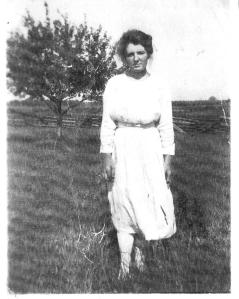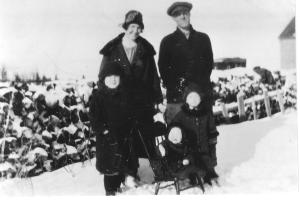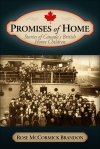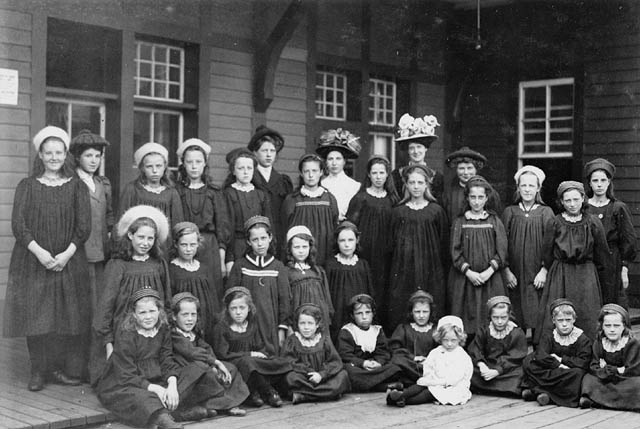A Child Immigrant Comes to Canada

Grace Griffin Galbraith, aged 15
This was written to celebrate Canada’s 150th; published in the Manitoulin Expositor. Always a pleasure to write about my grandmother, Grace Griffin Galbraith. – Rose McCormick Brandon
“I can never regret coming to Canada. I have had to work hard but I don’t mind that for I love to work.” Grace Griffin Galbraith, my grandmother, wrote these words in 1928. She was twenty-five and a perfect candidate for regret. She immigrated to Canada as an eight year-old with her sister, Lily. The two, and later their brother, Edward, arrived through a child immigration agreement between the United Kingdom and Canada. After their father’s death and their mother’s remarriage, Grace and her siblings were placed in the Annie MacPherson Home for Children in the east end of London, England. They remained there until their mother’s death, after which their paternal grandmother signed the Canada Clause giving the Home permission to send the children to Canada.
Thus, Grace became one of more than one hundred thousand children to immigrate to Canada between 1869 and 1939. She landed in Quebec on May 13, 1912.
Most child immigrants became indentured servants contracted to work as farm hands and mother’s helpers. Lily Griffin was sent to Toronto and Grace to a southern Ontario farm. At the end of her thirty-day trial period Grace was returned to MacPherson’s Canadian Home in Stratford because she “not wholly satisfactory.” This isn’t surprising since she had never been on a farm. Her next placement also ended after thirty days.
Grace’s third placement took her to Manitoulin Island. This home welcomed her at first but later reneged on their contractual responsibility to send Grace to school for at least three months each year. One day, a local minister, Rev. Munroe, arrived at the farm and found Grace in alarming condition. He immediately removed her and took her to live with a family that attended his church, the Gilpins. She stayed at this safe and kind home until her marriage at age seventeen.

Jim and Grace Galbraith and their 3 oldest children: Evelyn, Lorma & Mildred (baby)
One year after her marriage to James Galbraith, a farmer with Scottish roots, Grace received the sad news that Lily had died of tuberculosis. She wrote, “It was lonesome for me when Lily died. I missed her sisterly letters.”
Meanwhile, Grace’s brother, Edward Griffin, who had the good fortune to live with a couple who considered him a son and included him in their will, had returned to England where he visited relatives and contacted MacPherson’s for information about his sisters. On his return to Canada, he began a search for Grace. By the time he found her they had been separated for fourteen years.
Grace wrote, “I always have a longing to see some of my folks.” She also made the sad statement, “I can never remember seeing my mother.” How happy she must have been to reunite with her brother. Edward spent a lot of time on Manitoulin with Grace and then moved from Southern Ontario to Sudbury to be closer to her.
By 1928 when Grace wrote that she had no regrets about coming to Canada, she was married, had re-united with Edward and had four daughters. (A son arrived later.) Her difficult childhood days over, Grace’s writings reveal a full and happy life. “I have a good and loving husband and a good home. We have a 100 acre farm, a large barn and a fairly good house. Jim is very good to help me. He is very fond of children. We have our place paid for now and I must add that we have a 1918 model car but we intend dealing on a new one next spring.”
The Home Children were unprepared for the harshness and isolation of Canadian farm life. One boy expressed it this way: “When I landed on that farm, I looked up and said, ‘Oh God, where am I?’” Whereas most immigrants form communities in their adopted homelands, these children were scattered in ones and twos throughout Canada’s towns and farms. Like Grace, most had more than one placement making it difficult to put down roots.
As we celebrate Canada’s 150th anniversary, it’s estimated that the descendants of Canada’s child immigrants, the Home Children, make up ten percent of the population. This period in our history serves to remind us how much immigration practices have changed. Today, no serious consideration would be given to a program that sends children overseas to live with and work for strangers. What a debt our country owes these young ones who endured heartbreak and loneliness to become some of Canada’s hardiest and most dedicated citizens.
Grace might have become bitter. Instead, she, like most child immigrants, chose to find hope in her new land. Grace’s positive attitude is reflected in her statement – “I can never regret coming to Canada.”
Grace spent her last twelve years at The Lodge in Gore Bay on Manitoulin Island where she passed away at age ninety-nine in 2003.
 Promises of Home – Stories of Canada’s British Home Children by Rose McCormick Brandon is available for purchase here.
Promises of Home – Stories of Canada’s British Home Children by Rose McCormick Brandon is available for purchase here.



A beautiful dedication to your grandmother and our 150th Canadian celebration. Thank you for writing our stories.